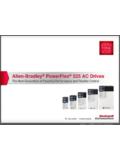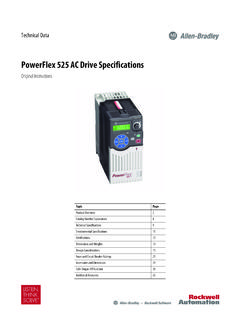Transcription of Modular Programming Tips in Studio 5000 Logix Designer
1 The purpose of this document is to discuss design considerations that will enhance user experience by fully utilizing the automation productivity features in Studio 5000 Logix Designer . The core features to be discussed are Subroutines, Add-On Instructions, Program Parameters and the Logical Organizer. The design considerations and examples in this document are merely suggestions. Users must determine which methodologies will best suit the needs of their engineering team. The below list summarizes the topics that will be discussed. Progression of Code Containers Subroutines Add-On Instructions Programs with Parameters Interface Layer Design Recommendations Embedding levels of Modularity Logical Organizer Controller Performance ConsiderationsIt is assumed that the reader is familiar with the topics covered in the following design guides.
2 The Logix5000 Controller Design Considerations (Pub# 1756-RM094H-EN-P) The Logix5000 Controller Add-On Instructions Programming Manual (Pub# 1756-PM010F-EN-P) The Logix5000 Controller Program Parameters Programming Manual (Pub# 1756-PM021A-EN-P)The development environment for Logix5000 controllers for Version 20 and below is named RSLogix 5000 . Beginning at Version 21, RSLogix 5000 was rebranded to Studio 5000 Logix Designer . For the purposes of clarity, this document will address both products generically as the Logix5000 design Programming Tips in Studio 5000 Logix Designer2 | Modular Programming Tips in Studio 5000 Logix DesignerProgression of Code Containers Let s take a moment to discuss the progression of code containers that are available within the Logix5000 design environment.
3 When Logix controllers were first introduced, code could be segmented into programs and routines. Users were limited in the number of programs that could exist in an application. Because of this limitation, the majority of code modules were in the form of routines and subroutines. As time progressed, Logix controllers were being used for increasingly complex applications which caused an increase in program size and complexity. This resulted in a need for more choices for code Version 16, a significant feature was introduced that gives users an additional method of segmenting code into smaller code modules.
4 The Add-On Instruction (AOI) is a noteworthy feature because it is a true definition. This means the logic within the code module exists in one place and can be used (instantiated) anywhere in the program. Additionally, Parameters are passed much more efficiently in AOIs when compared to subroutines. This improves scan-time performance as well as memory consumption within the Logix controller. AOIs are not online editable which makes them excellent for smaller code modules that will not require online edits after testing is complete. AOIs can be easily transported between applications using import and export.
5 AOIs are heavily used in current releases and will be discussed later in this Version 24, a new feature has been added that enables Parameters to be passed between individual programs. This allows a program to be used as a primary code container without the use of Controller Scope tags to read and/or write data to other programs. This functionality adds an additional layer of encapsulation when using programs for code segmentation. Programs and associated Parameters can be configured while online, which gives them an advantage when compared to AOIs.
6 This makes programs an excellent choice for code modules that may require ongoing online edits. The Logical Organizer was also introduced in Version 24 to aid users in organizing code modules. The Logical Organizer allows the user to define a multi-level, organization hierarchy of folders, programs and phases that represent their system. The use of these two features will be discussed extensively throughout this features combined cultivate a collaborative design environment that promotes organization and reusability. If utilized to its full potential, the Logix5000 design environment can help users create a library of common control functions that can be leveraged across many applications.
7 This can reduce time-to-market while increasing overall code section will discuss some high-level design tips for using Subroutines. The Logix5000 Controller Design Considerations (Pub# 1756-RM094H-EN-P) is available on Literature Library and contains excellent information on designing, creating and using Routines. Modular Programming Tips in Studio 5000 Logix Designer | 3 Basic understanding of the topics covered in that reference manual are imperative to properly designing and using to Consider Subroutines:After a functional specification has been broken down into smaller, less complex operations (code modules) it is time to start deciding which method to utilize to encapsulate each module.
8 When considering Subroutines, it is important to ask the following questions for each proposed code module: Is the code module reusable? Can the logic for this code module reasonably fit into one routine? Is there a relatively small number of tags to be passed to and/or from the code module? Does the code module already exist in a legacy controller (PLC-5 , SLC , or MicroLogix )?If the majority of the answers are yes, then Subroutines are a great option for that code module. Subroutines have been around for a long time and many users are familiar with how to design and use them.
9 They can be created and used in standard and safety applications and are easily transported between applications which makes them great for building code libraries. Additionally, Subroutines allow the passing of User-Defined Structures (UDT), which makes them very useful when a code module has a corresponding custom defined structure of tags. All input and output Parameters are passed by value. This means when the Subroutine is called, input parameter values are passed to the Subroutine. Output Parameters are passed out of the Subroutine after the Subroutine has completed execution.
10 Subroutines are a great option for semi-complex algorithms that can fit into a single routine and may require online editing. When using Subroutines, remember the following: It can be hard to troubleshoot running code when a Subroutine is called from multiple locations. It is highly recommended that users consider adding logic to the application that allows an instance of a Subroutine to be isolated. Of all of the available code containers. Subroutines require the most overhead to pass Parameters when called. If the application requires the absolute fastest scan-time, consider using other methods.












